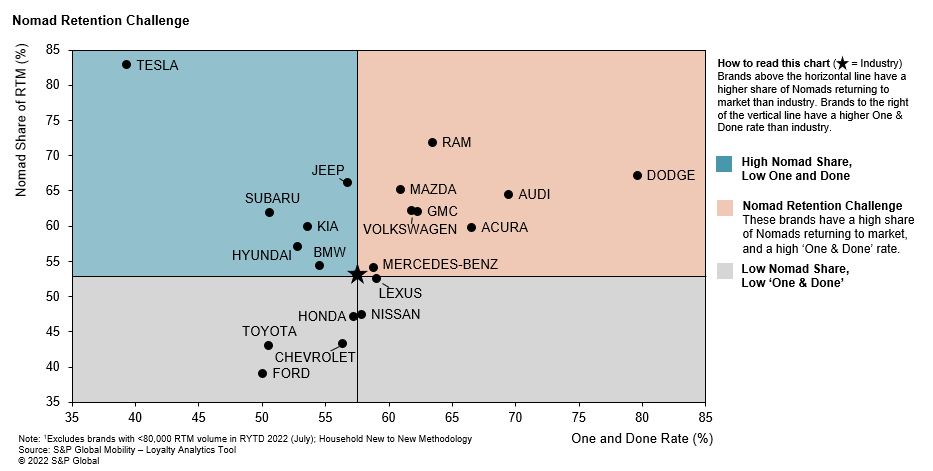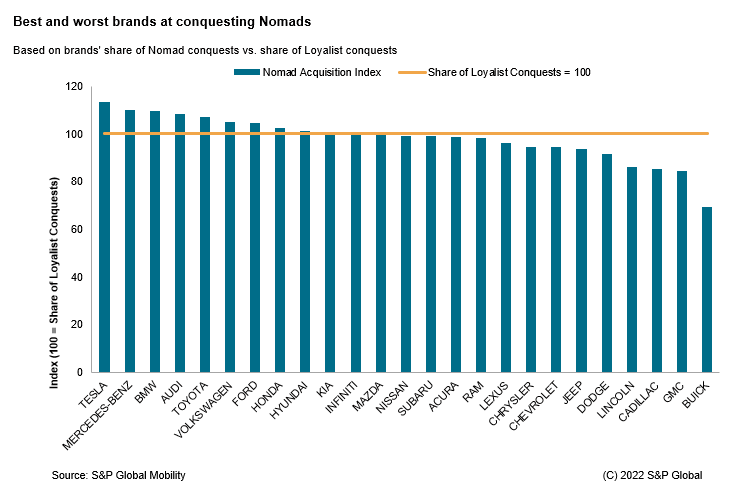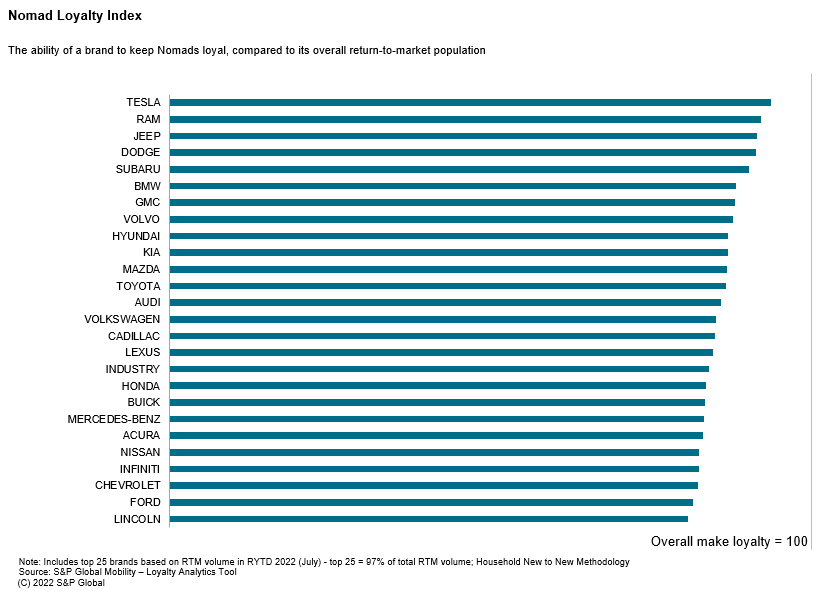Those car shoppers you’re strategizing to conquest from your
rival brands? Even if you win them over, there is a high
probability they won’t stick around.
Most automotive customers who are new to a brand often leave for
yet another brand when they return to market. In fact, more than
half of these “Nomads” make a habit of it.
Automotive marketers typically focus on two types of marketing:
conquest and loyalty. What is less often talked about is the
in-between – the loyalty of conquests. What does this mean? The
effort and triumph of a successful conquest-marketing campaign can
be undermined if automakers are losing most of their previous
conquests at the same time.
Nomads who own a brand once and leave are also known as ‘One and
Done’ – about 58 percent of Nomads left their brand in the 12
months ending July 2022. That’s the highest ‘One and Done’ rate
(defection rate of Nomads) in at least 10 years, according to data
analysis by S&P Global Mobility.
There are three distinct customer loyalty types: Super
Loyalists, Loyalists and Nomads. Super Loyalists are consumers with
a history of multiple repeat purchases and are most likely to
repurchase from the same brand. Loyalists are consumers with a
repeat purchase, and Nomads show no identifiable loyalty patterns
to any brand and are most likely to defect.
Brands who have a presence in more segments tend to have a lower ‘One and Done’ rate. Filling a portfolio gap (by launching a
vehicle in a key segment) helps brands retain nomads (and customers
in general).
Between 2017 and 2019, Subaru, Volkswagen, Hyundai, and Kia all
launched new models in the increasingly popular upper mid-size
utility segment – with the Ascent, Atlas, Palisade, and Telluride.
These roomier three-row models reduced the defection rate of the
brands’ overall return-to-market population and suggests that a
model launch is an ideal time to target Nomads who might leave for
a segment where their current brand isn’t represented.
How much does a ‘One and Done’ household impact brands? It
depends. Some brands have a higher-than-average share of Nomads
returning to market. For those, the impact of those customers
leaving is more significant, according to S&P Global Mobility
data.

Is a high share of Nomads a bad thing? Not necessarily. First,
newer brands like Tesla will obviously have a higher share of
first-time owners than an established brand like Ford. Even
established brands can have a higher share of Nomads when they’ve
ventured freshly into popular segments and successfully brought in
new customers. Volkswagen is a prime example, as the brand shifted
its portfolio to contain more sport-utility vehicles.
Best and worst brands at acquiring Nomads
Based on brands’ share of Nomad conquests vs share
of Loyalist conquests

Each brand has a unique position when considering product
portfolio, demographic profile, and geographic distribution of
their consumers. While conquest, loyalty, and loyalty of conquests
are all important, brands who have the highest concentration of
Nomads and the highest risk of losing them should focus on the
latter. And good news for those who are successful at conquesting:
the high ‘One and Done’ rate industrywide means there is prime
opportunity to conquest other brands’ Nomads.
“Loyalists have an average 13-point advantage on a brand’s
loyalty rate than Nomads,” said Erin Gomez, associate director of
consulting for S&P Global Mobility. “Brands that fail to
transform Nomads into Loyalists not only lose out on the immediate
sale to the Nomad, but also the future loyalty benefit they could
have provided as Loyalists.”
While Tesla’s high share of first-time owners (83%) isn’t too
surprising, their ability to keep those new customers is
extraordinary. Tesla’s ‘One and Done’ rate is just 39% compared to
58% for the industry (remember, a lower number is better in this
case). The next-best ‘One and Done’ rate goes to Ford at 50%.
However, Nomad share of Ford’s return-to-market households in less
than half of Tesla’s.
Because Loyalists are more likely to stay with the brand than a
Nomad (56% make loyalty for Loyalists vs. 43% make loyalty for
Nomads), turning a Nomad into a Loyalist not only keeps the
customer at that return-to-market event, but also makes them more
likely to stay with the brand when they are ready to buy again. If
a Nomad defects versus moving into the Loyalist bucket, the cost to
the brand is the sale to the Nomad but also, on average, 13
incremental percentage points of loyalty compared to replacing them
with another Nomad.
So, who are Nomads? Nomadic households tend to skew toward the
wealthiest families of highly educated professionals. They tend to
live in suburban neighborhoods and have high disposable incomes.
Households that fit this profile could be high risk for One and
Done if they chase the latest trendy product.

But a one-size-fits-all approach shouldn’t be taken when
identifying possible One and Done customers. Understanding and
segmenting the consumer and their propensity to move into certain
body styles, fuel types, and brands is also important. Consider a
brand that does not offer a pickup truck. It would not make sense
to attempt to retain a Nomad who owns a mid-size utility but who is
coming back to market for a pickup.
While one can look strictly at the One and Done rate (defection
rate of nomads), that’s only part of the story. Also important is
the brand’s overall loyalty rate. S&P Global Mobility has
created an index looking at a brand’s loyalty among nomads vs.
overall loyalty. For instance, Ford has a low ‘One and Done’ rate,
but they also have a high overall brand loyalty rate. Meanwhile,
RAM has a higher than average ‘One and Done’ rate, and also a low
brand-loyalty rate, because the brand’s portfolio is limited to
trucks. That said, relative to its overall brand loyalty, RAM
doesn’t do a bad job turning its Nomads into Loyalists, and might
look at focusing on manufacturer loyalty to ensure the Nomads
leaving the brand for a different body style stay within the
Stellantis family.
“Aside from the massive, long-term undertaking of creating
products in new segments, there are other ways automakers can
increase loyalty from their current Nomads,” Gomez said. “By
understanding the loyalty makeup of their customer base, and where
their Nomads are going, brands can take a more targeted and
efficient marketing approach to retain them.”
This article was published by S&P Global Mobility and not by S&P Global Ratings, which is a separately managed division of S&P Global.
- SEO Powered Content & PR Distribution. Get Amplified Today.
- Platoblockchain. Web3 Metaverse Intelligence. Knowledge Amplified. Access Here.
- Source: http://www.spglobal.com/mobility/en/research-analysis/the-trouble-with-nomads.html



